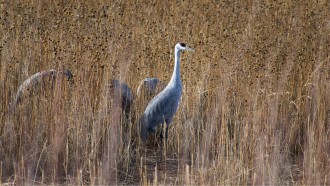Young Scientist: Sandhill Cranes
Young Scientist: Sandhill Cranes
December 13, 2024By AILEEN O'CATHERINE

Every fall and winter, New Mexico gets to host some special visitors. Tens of thousands of sandhill cranes (Antigone canadensis) migrate south from wetlands like those at Grays Lake National Wildlife Refuge in Idaho to fly to the Bosque del Apache National Wildlife Refuge near Socorro. By the end of November, most of the migrating birds have arrived for their winter stay. Many stop in the San Luis Valley of Colorado before they arrive in New Mexico, at what is termed a staging area, a place where the birds spend several weeks. In their spring flight north, the cranes again stop in this valley to choose partners before flying farther north to their nesting areas.
Sandhill cranes are some of the world’s oldest bird species. The fossil record shows they have hardly changed in millions of years, so they have adapted to many changes. By the early 20th century, the Middle Rio Grande Valley, where the birds maintained a flight path, saw many changes that affected the migrating cranes. The natural flooding of the Rio Grande was impacted by human habitation and by riverside drains that pulled water from the natural wetlands the cranes used for overwintering. In 1939, there were so few sandhill cranes in the Rocky Mountain population that they were listed as a rare species. Concerned conservationists established the Bosque del Apache to provide a wetland stopover site for the cranes as well as for other migrating waterfowl. In 1941, there were only about 1,000 sandhill cranes in the Rocky Mountain population, and 17 flew down to winter at the Bosque del Apache. Today, the Rocky Mountain population is about 27,000 birds. Eighty percent overwinter in the Middle Rio Grande Valley. Some winter further south in Mexico. Thanks to the efforts of conservationists, the cranes have rebounded and are no longer considered rare or endangered. The refuge has expanded since first opening in 1939, and today it totals 57,331 acres.
Every winter, tens of thousands of cranes touch down at the refuge, along with snow geese, Ross’s geese and other birds such as eagles, blackbirds, ravens and coots. Sandhill cranes spend the night in the water to protect themselves from predators. At dawn, groups of cranes fly off to feed in fields along the Rio Grande Valley. Early morning visitors to the Bosque del Apache can watch the dawn fly-out from mid-November through late January, when thousands of birds take to the air in search of food. In spring, the cranes fly north to their nesting grounds, and the annual cycle begins again.
The greater sandhill crane stands 4 feet (1.2 meters) tall and has a wingspan of 6 to 7 feet (2-2.1 meters). They often migrate 1,000 miles (1,600 km) at speeds of 25-35 miles per hour (40-56 kilometers per hour). While their diet consists mainly of seeds, grains and berries, they also eat small reptiles, fishes, frogs and insects.
Sandhill cranes mate for life. Partners are chosen based on dancing displays, when the male stretches its wings, pumps its head, bows and leaps into the air. Females usually lay two eggs. Mated pairs and their juvenile offspring stay together through the winter until they separate in the spring. During migration and over the winter, family units stay together with other families and non-breeders to form loose flocks. It is these flocks that visitors to the Bosque del Apache come to see every year.
The Bosque del Apache’s 35th Festival of the Cranes will be Dec. 11–5. Visitors can see thousands of cranes, ducks, snow geese and other migratory birds, take a tour of the refuge, and learn more at information booths and talks. Take binoculars or purchase some there.
Other places to observe migrating sandhill cranes in New Mexico include the Ladd S. Gordon Waterfowl Complex in Bernardo, north of Socorro on Interstate 25, Exit 175. The city of Albuquerque’s Open Space Visitor Center at 6500 Coors Blvd NW hosts an annual crane celebration, and through the winter, visitors can often observe sandhill cranes from the center.

